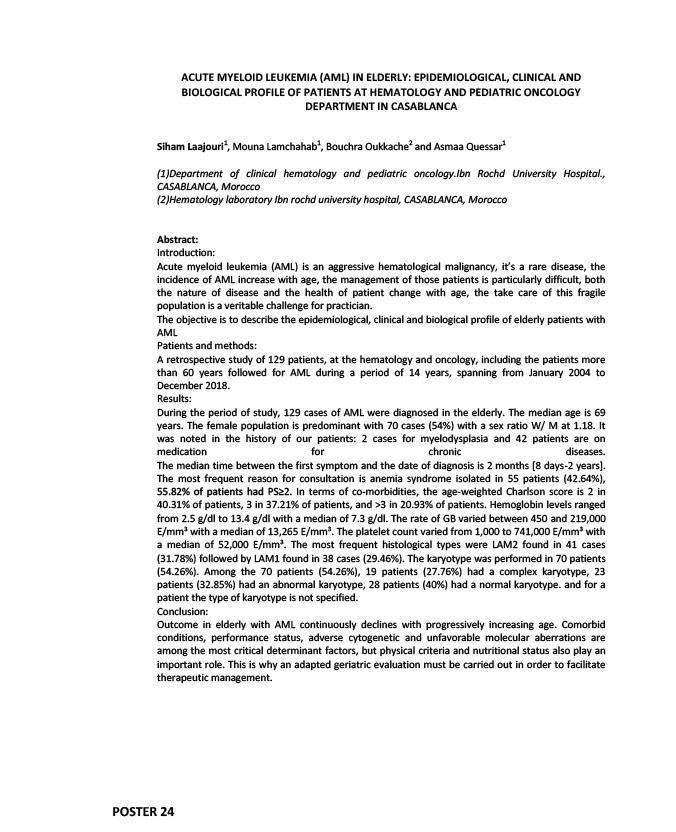
POSTER 24
ACUTE MYELOID LEUKEMIA (AML) IN ELDERLY: EPIDEMIOLOGICAL, CLINICAL AND
BIOLOGICAL PROFILE OF PATIENTS AT HEMATOLOGY AND PEDIATRIC ONCOLOGY
DEPARTMENT IN CASABLANCA
Siham Laajouri1, Mouna Lamchahab1, Bouchra Oukkache2 and Asmaa Quessar1
(1)Department of clinical hematology and pediatric oncology.Ibn Rochd University Hospital.,
CASABLANCA, Morocco
(2)Hematology laboratory Ibn rochd university hospital, CASABLANCA, Morocco
Abstract:
Introduction:
Acute myeloid leukemia (AML) is an aggressive hematological malignancy, it’s a rare disease, the
incidence of AML increase with age, the management of those patients is particularly difficult, both
the nature of disease and the health of patient change with age, the take care of this fragile
population is a veritable challenge for practician.
The objective is to describe the epidemiological, clinical and biological profile of elderly patients with
AML
Patients and methods:
A retrospective study of 129 patients, at the hematology and oncology, including the patients more
than 60 years followed for AML during a period of 14 years, spanning from January 2004 to
December 2018.
Results:
During the period of study, 129 cases of AML were diagnosed in the elderly. The median age is 69
years. The female population is predominant with 70 cases (54%) with a sex ratio W/ M at 1.18. It
was noted in the history of our patients: 2 cases for myelodysplasia and 42 patients are on
medication for chronic diseases.
The median time between the first symptom and the date of diagnosis is 2 months 8 days-2 years.
The most frequent reason for consultation is anemia syndrome isolated in 55 patients (42.64%),
55.82% of patients had PS≥2. In terms of co-morbidities, the age-weighted Charlson score is 2 in
40.31% of patients, 3 in 37.21% of patients, and >3 in 20.93% of patients. Hemoglobin levels ranged
from 2.5 g/dl to 13.4 g/dl with a median of 7.3 g/dl. The rate of GB varied between 450 and 219,000
E/mm³ with a median of 13,265 E/mm³. The platelet count varied from 1,000 to 741,000 E/mm³ with
a median of 52,000 E/mm³. The most frequent histological types were LAM2 found in 41 cases
(31.78%) followed by LAM1 found in 38 cases (29.46%). The karyotype was performed in 70 patients
(54.26%). Among the 70 patients (54.26%), 19 patients (27.76%) had a complex karyotype, 23
patients (32.85%) had an abnormal karyotype, 28 patients (40%) had a normal karyotype. and for a
patient the type of karyotype is not specified.
Conclusion:
Outcome in elderly with AML continuously declines with progressively increasing age. Comorbid
conditions, performance status, adverse cytogenetic and unfavorable molecular aberrations are
among the most critical determinant factors, but physical criteria and nutritional status also play an
important role. This is why an adapted geriatric evaluation must be carried out in order to facilitate
therapeutic management.